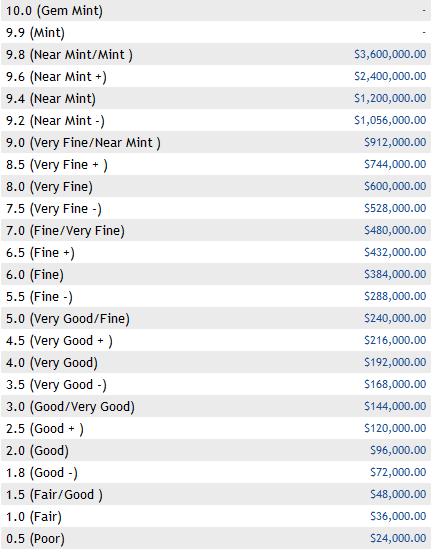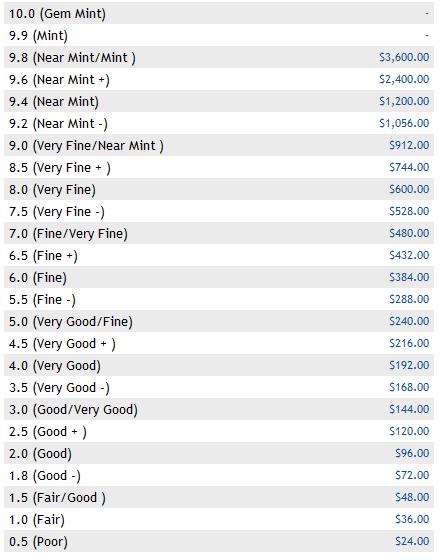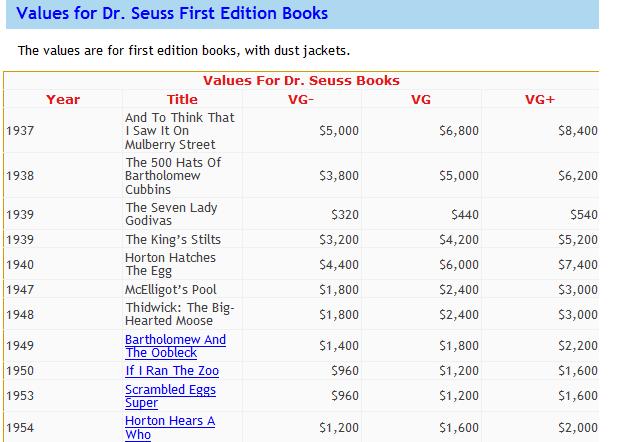
Book grading is one of the most ambiguous factors in collectible books. Quite frequently when I am in the process of obtaining Oz books from a private individual and ask him or her about the book condition, I get a reply that the books are in “very good” condition. Once, however, the seller begins to answer my specific inquiries, he or she begins to realize that what they consider to be “very good condition” is in fact far from it. I do not mean to suggest that the sellers are ignorant. The difficulty lies in the fact that there is no clear standard for grading books, even though one is truly needed. Perhaps, it is worth examining the book grading standards that do exist for somewhat similar collectibles – comics books.
You may have heard of the recent sale of one the comics books from 1930s for $1,000,000. My research also revealed that some comics books are selling on Ebay for over $10,000 on a weekly basis. I began to wonder: what do these comics books have in common with Oz books, other than being rare?
I noticed that almost all expensive comics books have independent book grading number that is assigned to them by the Certified Guaranty Corporation, or CGC. CGC is a third-party comics book grading service that assigns a number on the scale of 1 to 10 for the comics book condition. After grade 9, which means that the book is in near mint or mint condition, comics books condition is graded with .1 increments so you can see grading between 9.1. and 9.9.
Below is the book grading scale used to identify the condition of comics:
Scale ---- Book Grading
9.8 - 10 – Mint
9.0 - 9.7 - Neat Mint
7.5 - 8.9 - Very Fine
5.5 - 7.4 – Fine
3.5 - 5.4 - Very Good
1.4 - 3.4 – Good
1-1.3 – Fair
Below 1 - Poor
Knowing this scale, I decided to analyze the price fluctuation for the same books but with different grade conditions. This is what I had observed studying the Comics Price Guide: the price increases by 50% between Poor and Fair condition, by 266% from Fair to Good, by 200% from Good to Very Good, by 200% from Very Good to Fine, by 156% from Very Fine to Near Mint, and by 300% + (!) from Near Mint to Mint. The same progression holds true for both expensive and least expensive comics books.
Book Grading: High Price comics

Book Grading: Lower Price comics

I then attempted to apply the same pricing methodology that is used in comics books to Rare Oz books and see how it will affect the Oz books prices.
First, let me note that for the collectible books there are generally only few book grading levels - Poor, Fair, Good, Very Good, Near Fine, Fine. Assuming that Oz book in poor condition is worth $10, then the same book in Fair condition will be worth $15, in Good condition it will be worth $39.90, in Very Good condition it will be worth $79.80, in Near Fine (625% increase - Near Mint in comics) - $498.75 and in Fine (Mint in comics) - $1496.25!
Of course, these are all theoretical prices based on the closest pricing methodology, but it nicely illustrates points of price fluctuation based on the condition. For example, average Oz book in Good to Very Good condition sells on Ebay for under $100, which matches my analysis of the price of that book in Very Good condition to be $79.80. It is shocking, therefore, for some buyers that the same book may sell for over $1000 if the condition so warrants. Also, the addition of an original dust jacket to the same book will double or triple or even more, the price of the book.
Look at the images below from three different books dealers that sell Oz books in dust jackets through Abebooks. Their prices affirm my observations.



Of course, each book price has to be evaluated independently. The only way anyone can accurately determine edition, gauge condition and scarcity and price a book appropriately is by having handled thousands of similar books, and, more importantly, by having compared multiple copies of the same title. In my case, I know which books are rare, which books are never found in fine condition, which books can be expected to be in fine condition, etc.
Another category of books that is closely related to Oz books is the category of childrens picture books. For example, in Dr. Seuss series books, the difference between Very Good- to Very Good+ condition is almost 70%.

I then examined the variations in prices of modern first edition collectible books. These are the prices that I found at http://modernfirsteditions.net for the title “To Kill a Mockingbird” by Harper Lee:
Value:
First Printing:
Fine in Dust Jacket, $40,000
Very Good in Dust Jacket, $12,000
Fine without DJ, $4000
Very Good without DJ, $1500
Second Printing:
Fine in Dust Jacket, $4500
Very Good in Dust Jacket, $1500
From all these examples of books prices, it is only reasonable to conclude that the Oz books’ prices should follow the same patterns. Another interesting observation that I made is how the designation of condition of comics books is different from that of rare books, such as Oz books, with the biggest difference being the level of attention paid to even the tiniest detail in the book grading system applicable to comics books. Below is a description from the Independent Online Booksellers Association’s (“IOBA”) “Near Fine” book (http://www.iobabooks.com):
“NEAR FINE: a book approaching FINE (or AS NEW or MINT) but with a couple of very minor defects or faults, which must be noted.”
Below is description for “Near Mint” for comic books:
”NEAR MINT ( NM :100% , NM- : 90%; Overstreet 97-90 )
Nearly perfect. Cover is flat with no surface wear. Cover inks are bright with high reflectivity and with a minimum of fading. Corners are cut square and sharp with ever so slight blunting permitted. Staples are generally centered and clean with no rust. Cover is well centered and firmly secured to interior pages. Paper is supple and like new. Spine is tight and flat.
Tears: None allowed.
Corner Bends: Only allowed if hardly noticeable.
Spine Stress Marks: Only allowed if hardly noticeable.
Staples: Tight, clean, no rust, and centered.
Writing: None allowed with the exception of autographs.
Rubber Stamps: None allowed.
Tape: None allowed.
Pieces Missing: None allowed with the exception of tips of pages nicked during the production process.
Fingerprints: When noticeable they drop the comic down to Fine.
Water stains: None allowed.
Browning Paper: None allowed except in the instance of oldercomics (such as a 12 cent comic) that may have oxidized due to their extreme age. Even then, it must be hardly noticeable.
Spine Rolling: None allowed.
Off-Center Printing: Only allowed if hardly noticeable.
Cover Scuff Marks: Only allowed if hardly noticeable.”
I hope from these descriptions you can make your own conclusions why most of the ambiguity is eliminated in comics books but is still present in any other books series. It may help consumers if a comparable independent book grading service existed for rare books as it may offer buyers a piece of mind by eliminating the condition factor from the equation.
However, that type of service would mean that the book will be sealed and thus, the buyer would not be able to inspect it. It has always been important to the collectors to have their books on shelves, where they can take them down, hold them in their hands, and yes, open them up and show the pages and inscriptions to guests. Collectors would not be happy with their books in sealed containers. Giving books a very specific condition grade WITHOUT sealing the book away to permanently preserve that condition would require a system with extremely explicit documentation of every aspect of the book, a considerable amount of labor when compared to simpler objects, like a coin or a baseball card. And while there are many parallels between book condition issues and comic book condition issues, books tend to be much more complex objects, particularly regarding the binding of multiple signatures, and so have a wider variety of potential flaws. If one looks at auction catalogs and dealer catalogs as a mirror of the desires of the market, showing a photograph of the exterior of the book is a relatively recent phenomenon, one tends to find older catalogs that do illustrate authorial inscriptions, title pages, and important illustrations and engravings. In other words, historically book collectors, though they wanted the object, have tended to value it for what is inside to a considerable degree. For many collectible books it is the interior that wants to be on display.
Collectors do want to know that their first editions are authentic, and the wide disparity in book grading and descriptions is certainly frustrating to many of them. More people have the tools to identify first editions than in the past. Regarding differences in condition, while photos are only additional tools in accurately conveying the books condition, they help a great deal. I personally would trust a decent photograph of a book more than some stranger telling me that the book is “very good” . This is the main reason why I take an average of 25 photos of each book for collectors to view in order to enable them to make an informed choice about the books condition, not just to take my word for it. The expression “I rather see it once instead of hearing 1000 times” is truly applicable to collectible books.
I would like to leave you with one final note: don’t be afraid to ask questions. And, beware of dealers who are reluctant to show you multiple pictures of the book you are interested in. As a consumer and a book collector, you deserve to know exactly what you are getting. As with all investments, the value of books can change. You will, however have the bonus of being able to touch and feel your investment. After all, you are not just buying an item – you are acquiring an important piece of American literature.
Return from this Books grading article page to Oz Newsletter page
Return from this Book grading page to Wizard of Oz books home page